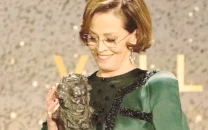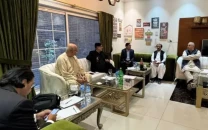Mazaar, Bazaar revisited
Book focuses on the symbolism that explicates the diversity and visual vernacularof Pakistan.

Saima Zaidi shares that the imagination of Pakistanis is dictated by old-world charm. PHOTOS: PUBLICITY
Four years ago, Saima Zaidi, who teaches at the Indus Valley School of Art and Architecture, published a book titled Mazaar, Bazaar; the book is an inter-disciplinary study on design and visual culture that focuses on the symbolism that explicates the diversity and visual vernacular of Pakistan.

In her book discussion, which took place at the Oxford University Press bookstore on January 22, Zaidi shared why she compiled the book: “To discover who we are as a nation. Through this work and the images, I have been able to explore and communicate it [our identity].”
With over 33 contributions from leading experts in one book, she delves into Pakistan’s consumer culture and icons and said that, for her, compiling the book “Wasn’t just a labour of love, but a labour of love and torture since it took [her] six years to assimilate all these wonderful things.”
Zaidi highlighted that Pakistanis are romantics to the core, “with old-world charm that significantly dictates their imagination.”
She pointed out the intricacies and visual impact of Tibet Talcum Powder’s bottle. The bottle shows a young girl, “who epitomises purity and is looking away from the prying eyes of men.”
She shared a poster that sheds light on the pehlwan culture in Pakistan. She shares that it is a classic case in point of masculinity as generally viewed in the country.
Focusing on the confluence of art and culture, Zaidi said, “Now is when it is safe to say that the cinema culture is being revived. Look at the cinematic poster of Zinda Bhaag, for instance, “which is reminiscent of the posters of yesteryear — it provides breathing space, which is nowhere to be seen in the other cinema releases.”
She showed the painting of Khusrau and Shirin (from the eponymous Persian tragic romance), which makes one view Pakistani culture as “heterogeneous, with diverse people inhabiting its regions.” although Khusrau was a Persian king and Shirin, an Armenian princess, the folklore is truly traditional and subcontinental.
In another example, she shared the visual treat that Thatta’s Shah Jahan Mosque is; it has calligraphic notes on it, but they are hardly legible. Thus, they essentially serve to showcase the beauty and opulence of calligraphic work.
Books like Mazaar, Bazaar, which juxtapose historical evidence with contemporary writing, are essential in reminding us of how rich and interesting Pakistan’s cultural expression is. After a thought-provoking, visually enlightening discussion, Zaidi concluded, “Our forefathers had dreams for this country. They wanted it to stand out as best amongst the rest, we were a pluralistic society that celebrated diversity in all its form. Who we were, we were so proud of!”
It is indeed time to embrace our identity and be proud of it... again.
Published in The Express Tribune, January 24th, 2014.
Like Life & Style on Facebook, follow @ETLifeandStyle on Twitter for the latest in fashion, gossip and entertainment.

















COMMENTS
Comments are moderated and generally will be posted if they are on-topic and not abusive.
For more information, please see our Comments FAQ